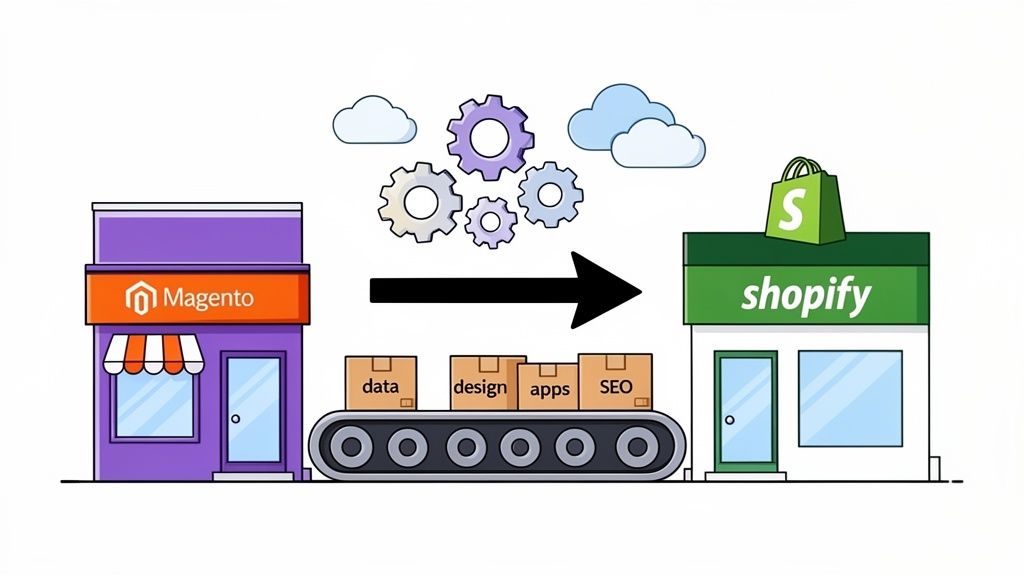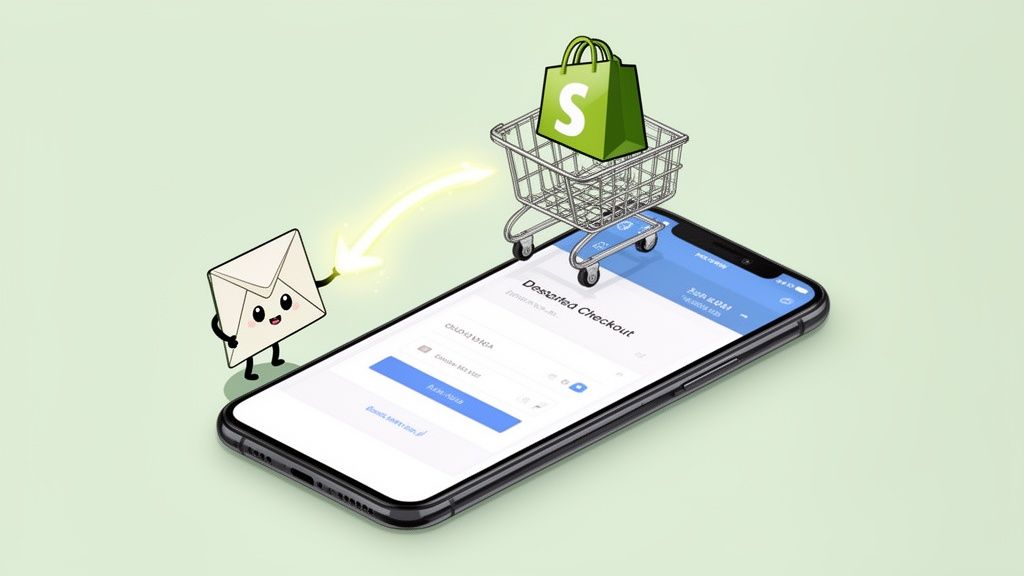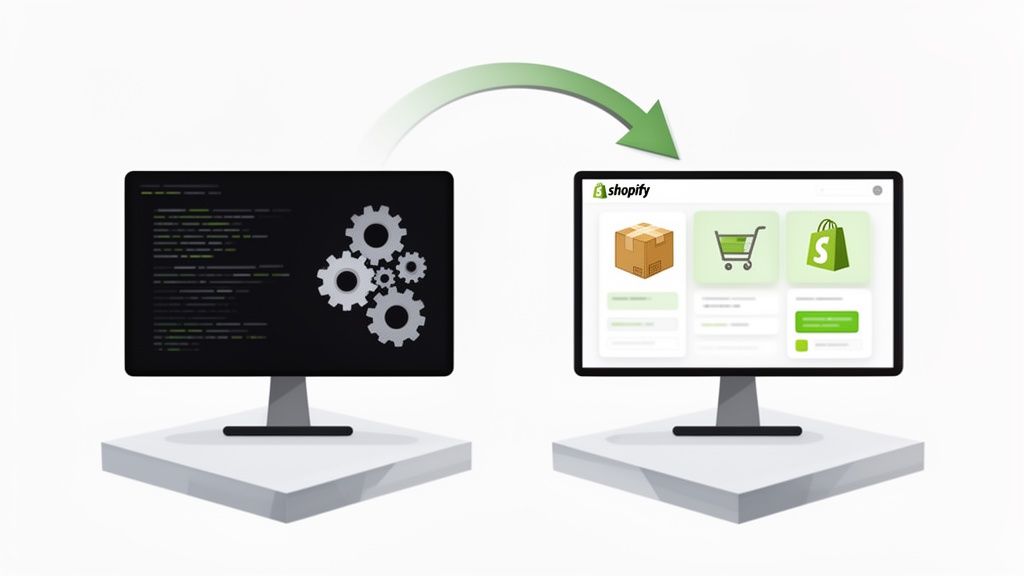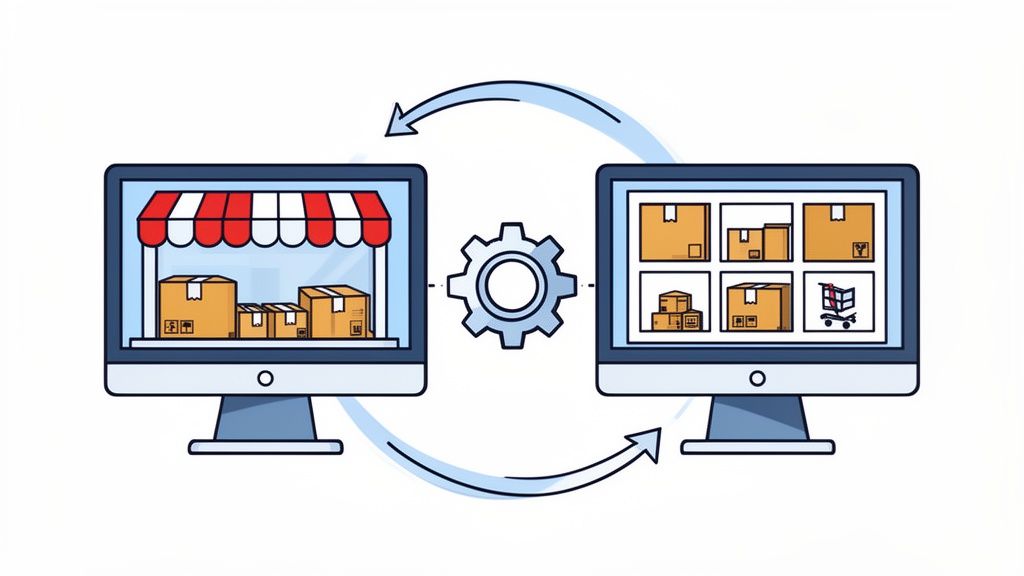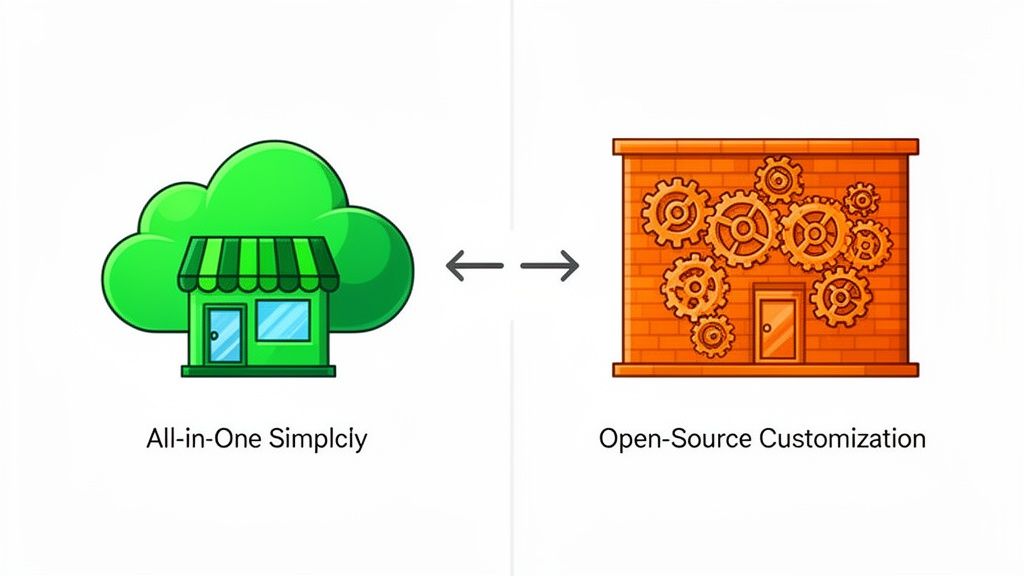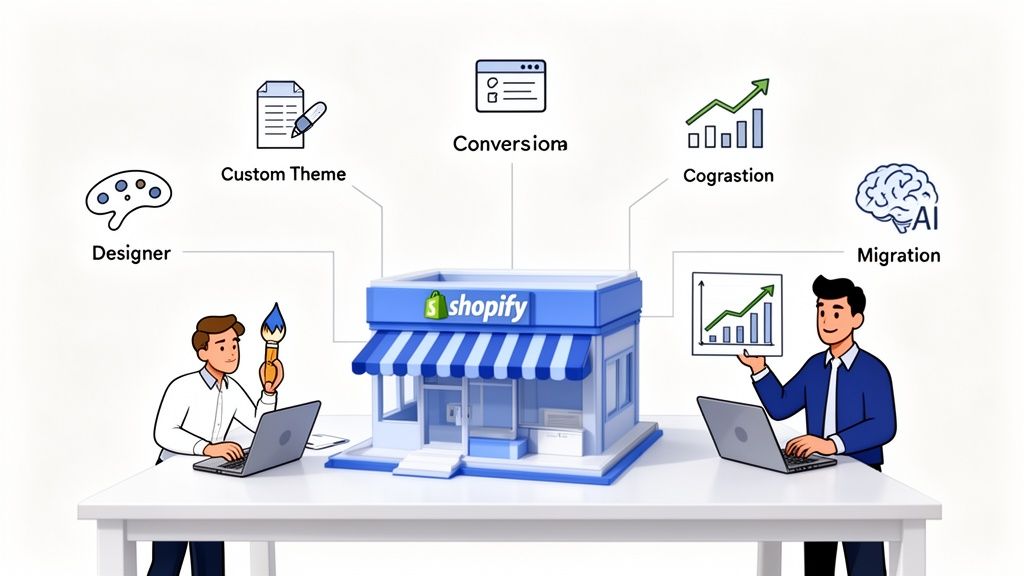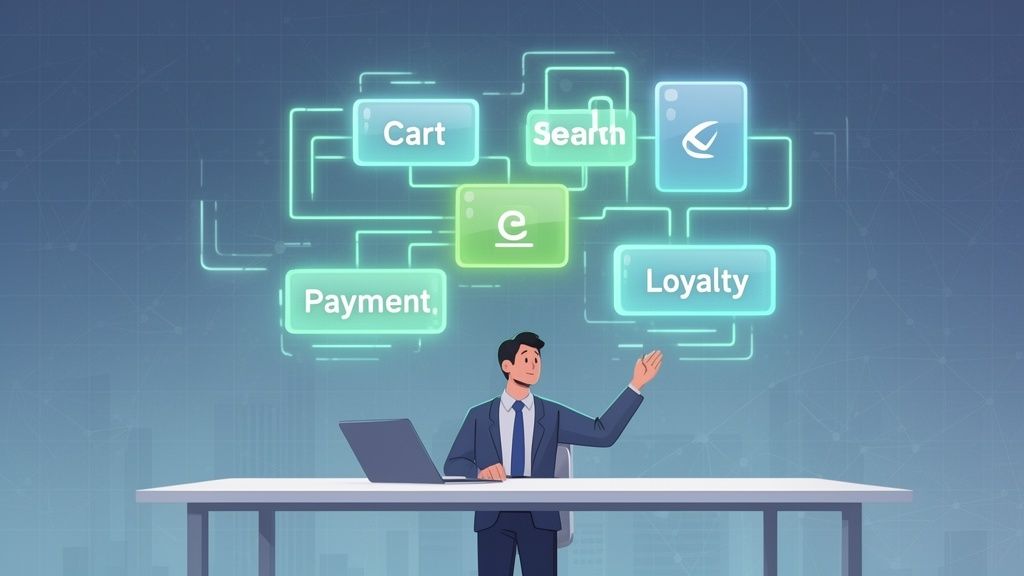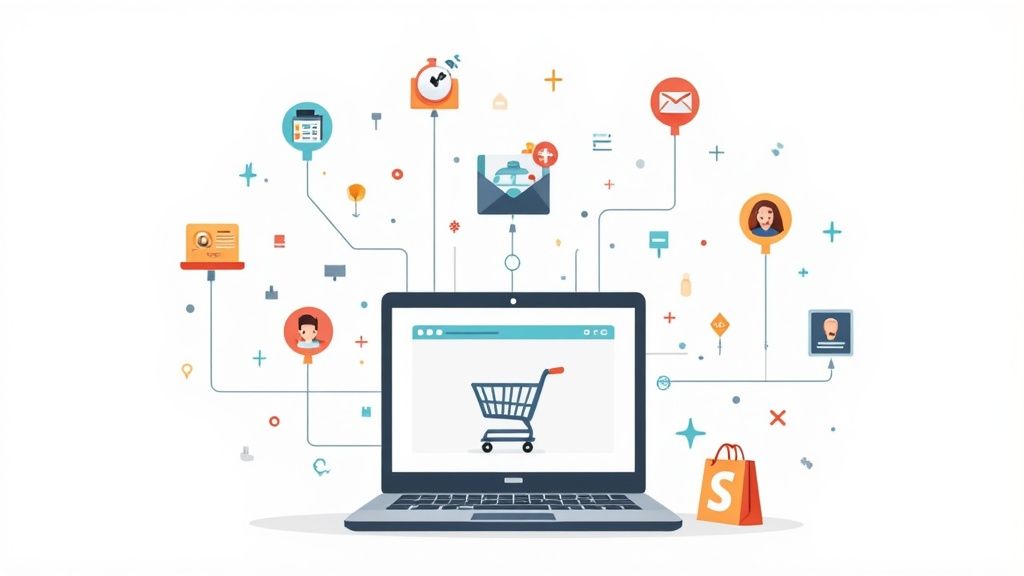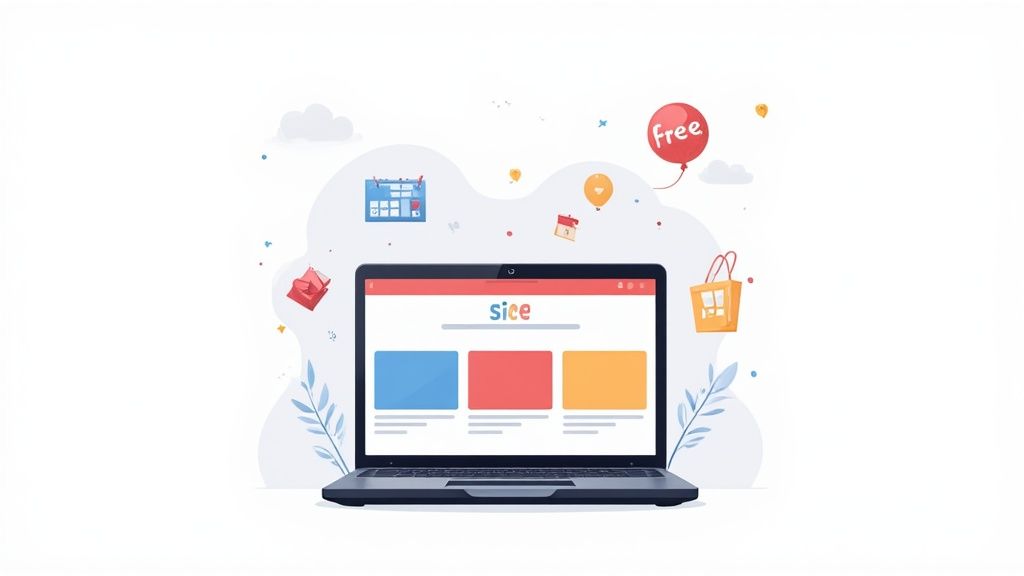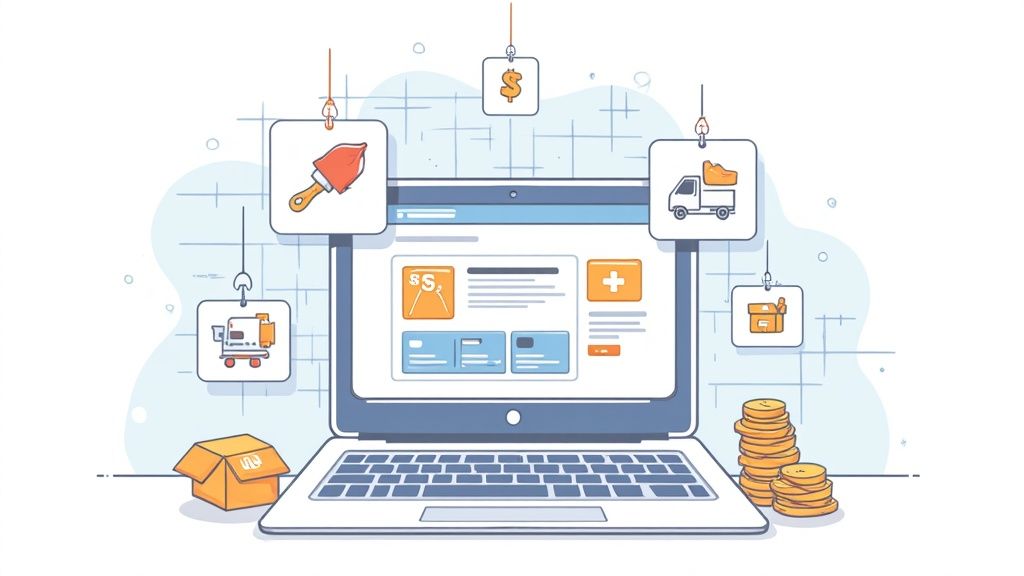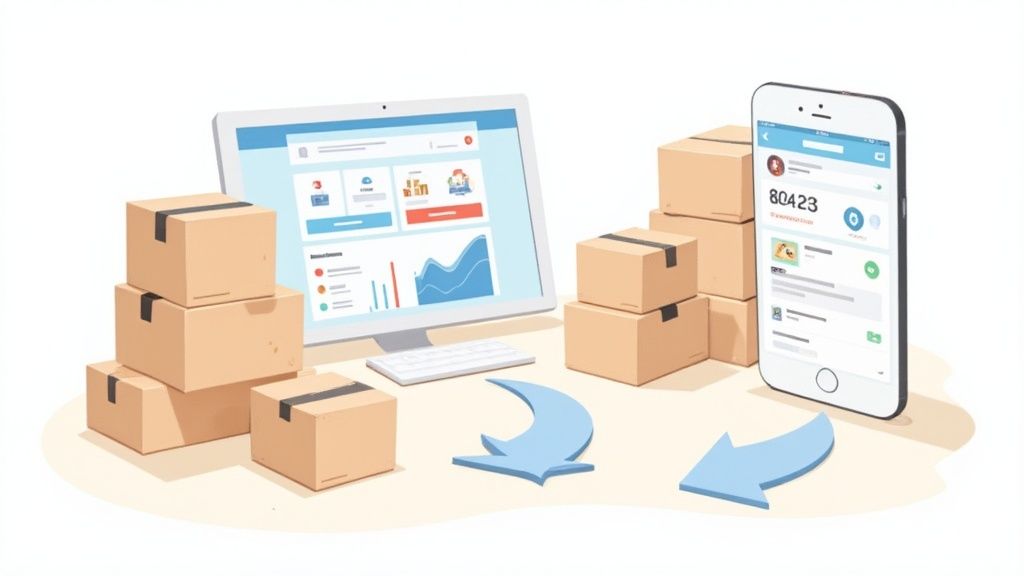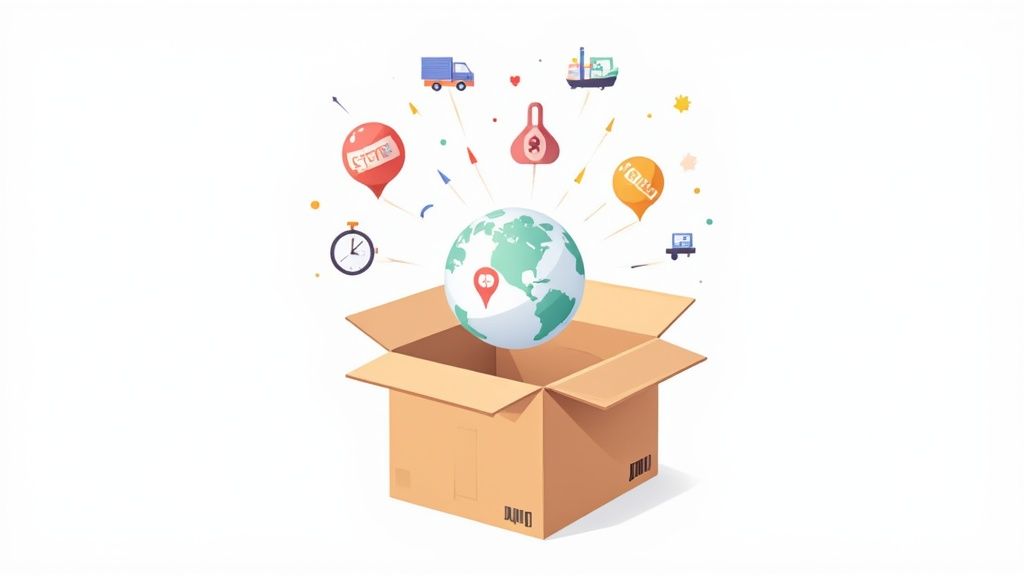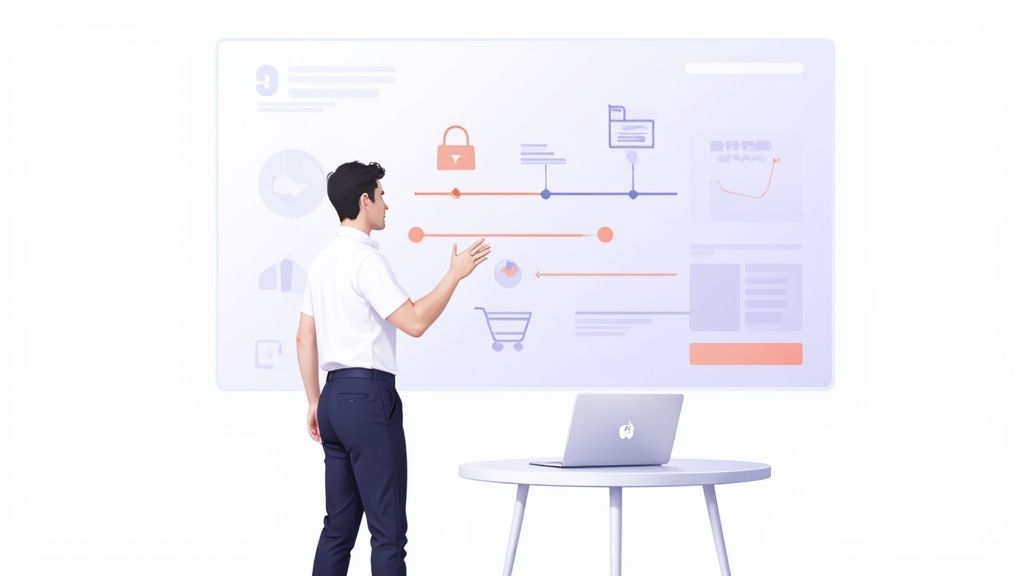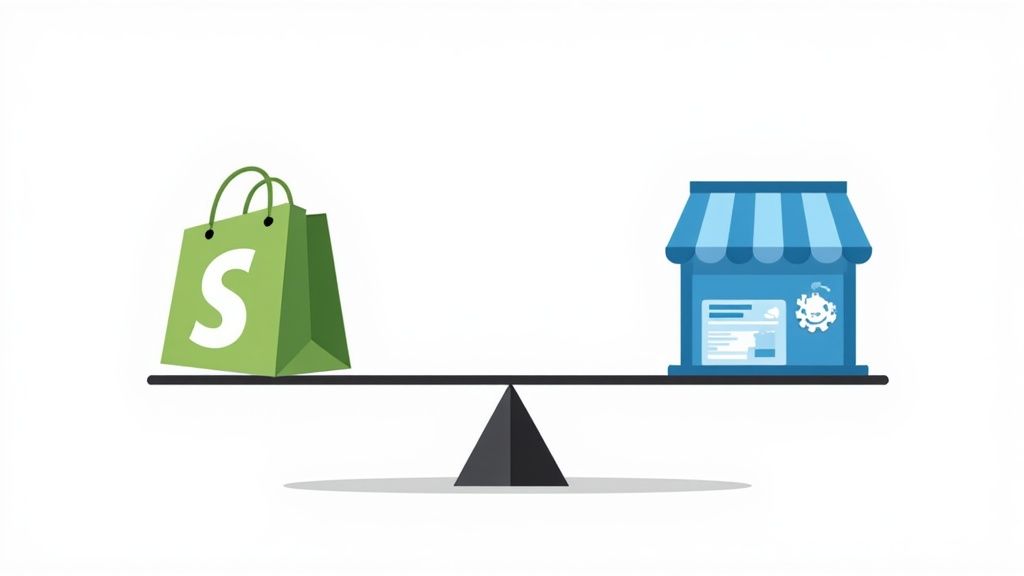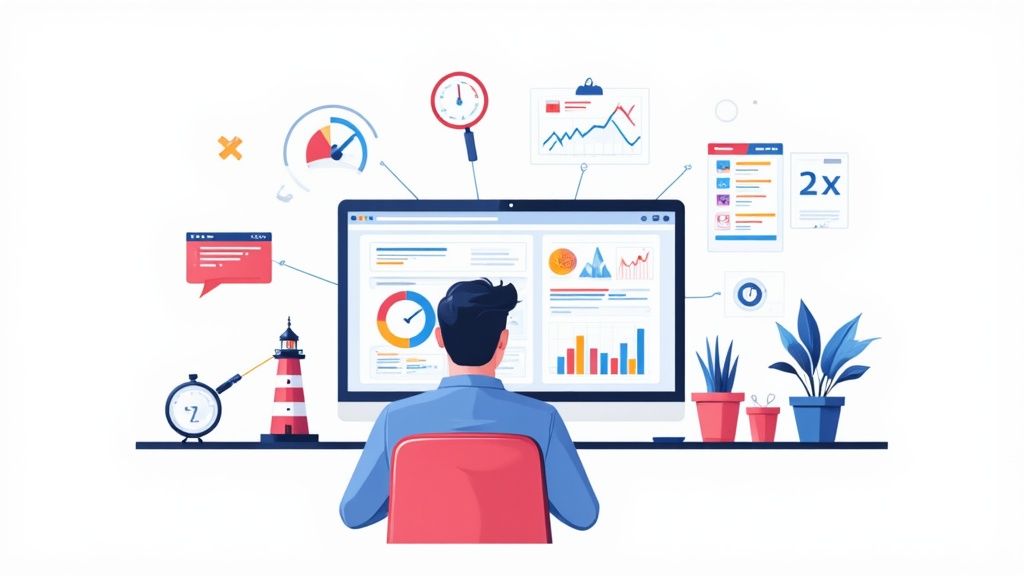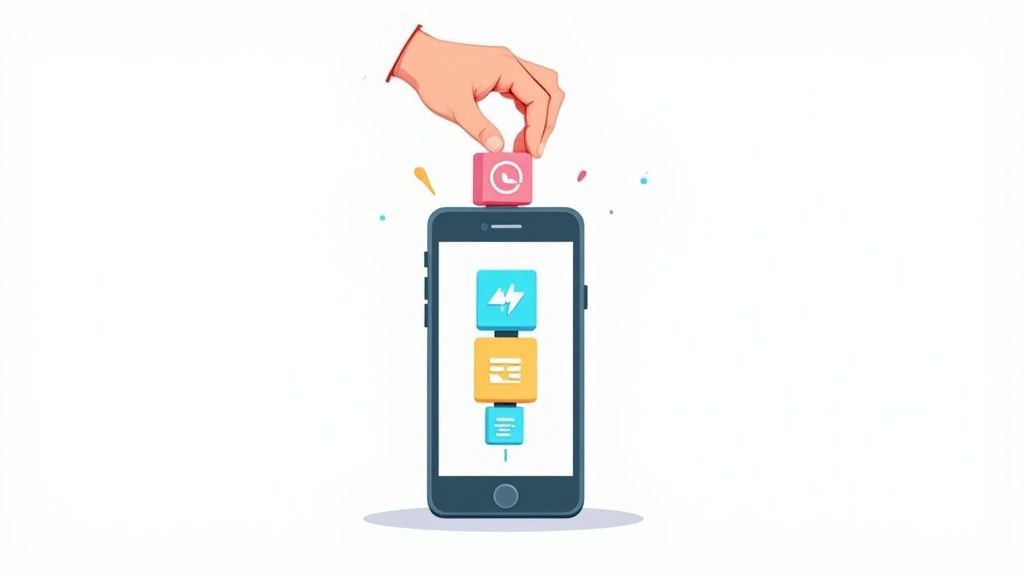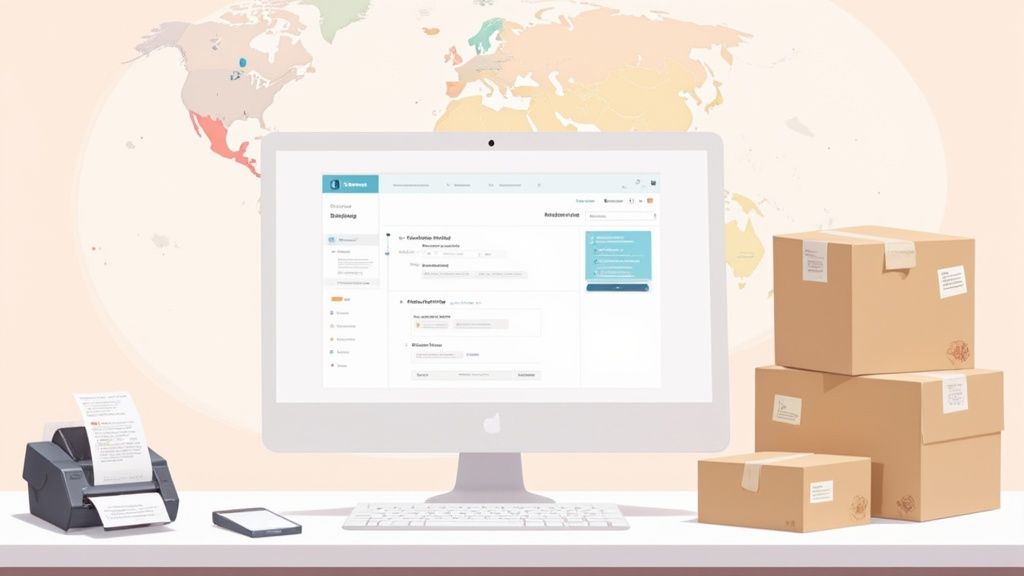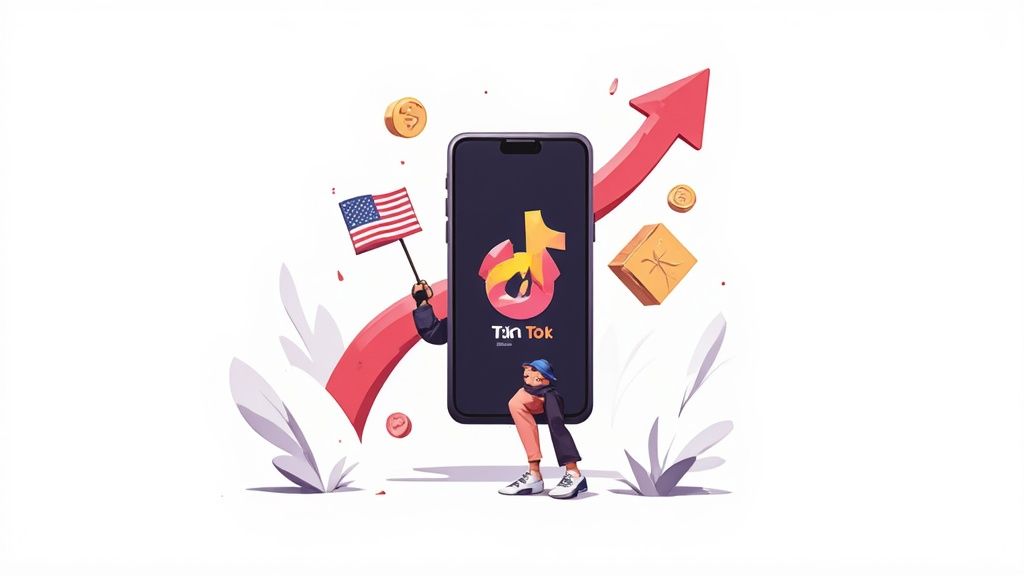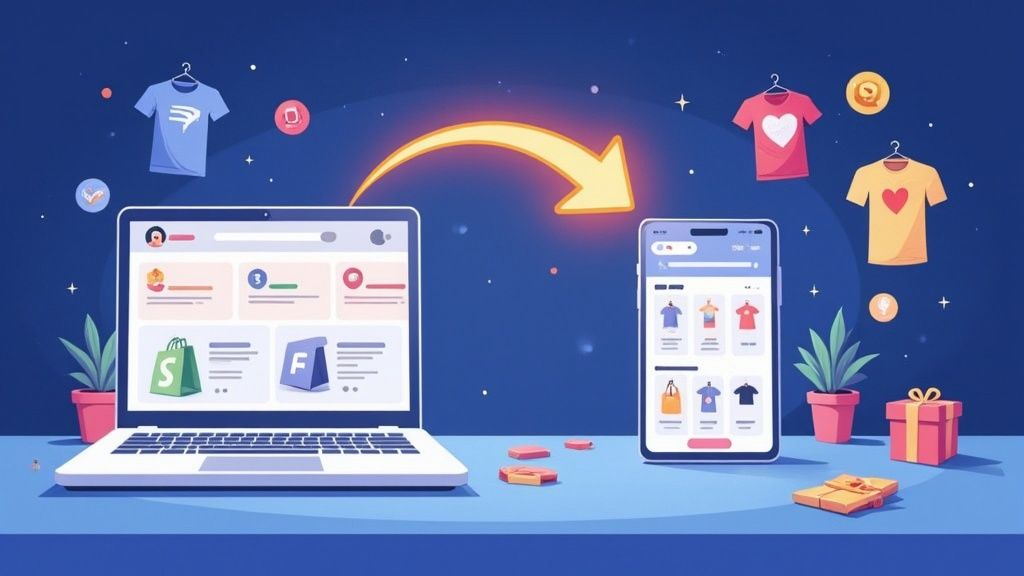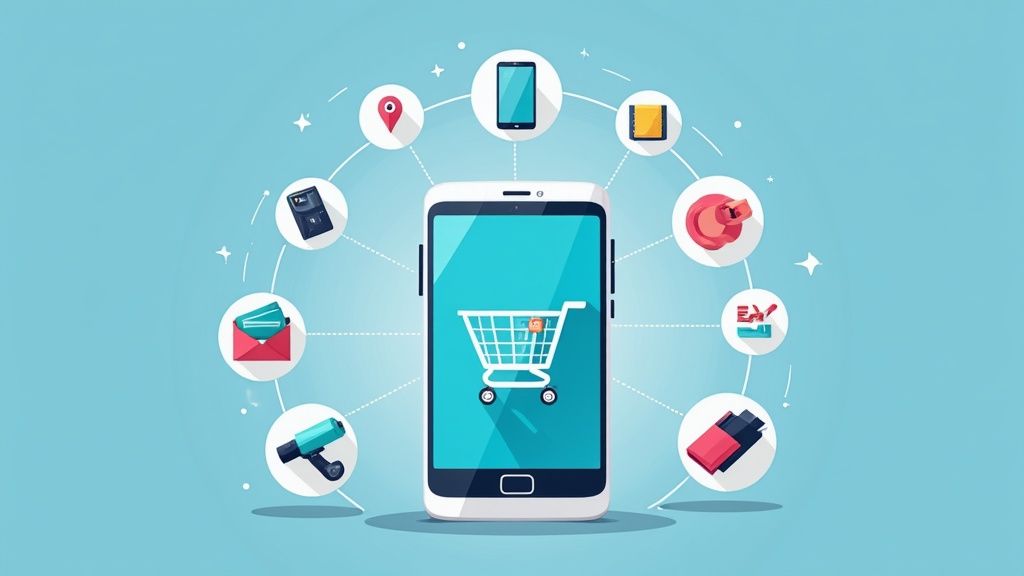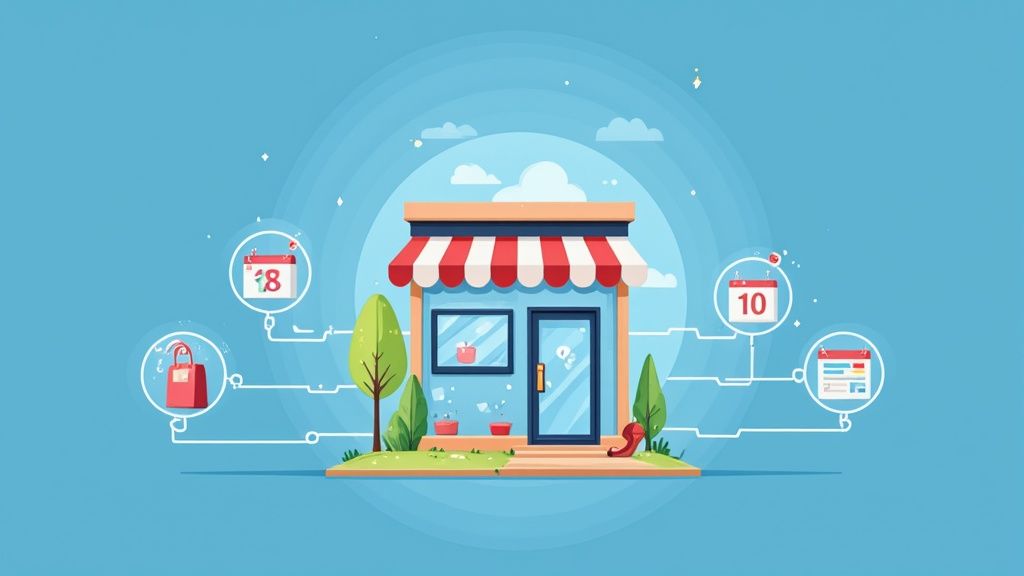
In a fragmented retail environment, customers don't see channels; they see a single brand. The disconnect between your mobile app, physical store, and social media feed can be the difference between a loyal customer and a lost sale. This is where effective omnichannel marketing strategies transform your business from a collection of separate touchpoints into a unified commerce ecosystem.
Moving beyond simple multichannel tactics, omnichannel marketing focuses on creating one seamless and integrated customer experience. It’s about ensuring that the customer's journey is consistent and contextual, whether they're browsing on a laptop, using an in-store kiosk, or interacting with a voice assistant. A true omnichannel approach means that a shopper can start a cart on their phone, view the item in a physical store, and complete the purchase on their tablet without any friction. This unified experience is no longer a luxury; it's a core expectation for modern consumers.
This article dives deep into 10 advanced omnichannel marketing strategies that are shaping the future of commerce. We won't just cover the theory. Instead, we'll provide a blueprint for execution, breaking down complex concepts into actionable steps. You will learn how to implement everything from a unified Customer Data Platform (CDP) to augmented reality shopping experiences. We’ll explore practical implementation guides, real-world examples from leading brands, and specific insights to help you build a truly cohesive brand presence that resonates with today’s shoppers and drives sustainable growth. Let's get started.
1. Cross-Channel Customer Journey Mapping
At its core, cross-channel customer journey mapping is the process of visualizing every interaction a customer has with your brand, across every channel, from initial awareness to post-purchase loyalty. This powerful technique moves beyond siloed channel analysis to create a unified, holistic view of the customer experience. By understanding how users transition between your website, mobile app, physical stores, and social media, you can identify friction points and opportunities to create a truly seamless journey. This is a foundational element of effective omnichannel marketing strategies, ensuring consistency and context at every touchpoint.
The goal is to eliminate jarring transitions, such as a customer seeing a promotion on Instagram but finding it unavailable in-store, or receiving an email about a product they just purchased. When done correctly, this strategy allows for personalized, context-aware interactions that make customers feel understood.
How to Implement This Strategy
Implementing a cross-channel journey map involves a systematic approach to data collection, analysis, and optimization. It requires collaboration between marketing, sales, and customer service teams to ensure all perspectives are included.
- Start with Key Segments: Instead of trying to map every possible customer path, focus first on your most valuable and common customer segments.
- Gather Multi-Channel Data: Collect data from all touchpoints, including web analytics, CRM data, social media engagement, in-store feedback, and support tickets.
- Validate with Feedback: Use surveys, interviews, and reviews to confirm that your mapped journey accurately reflects the real-world customer experience.
- Invest in Technology: Use a Customer Data Platform (CDP) or robust analytics tools to consolidate data and track user movements across different channels. For more in-depth examples, you can learn more about customer journey mapping best practices.
This infographic outlines the core workflow for creating and activating a dynamic customer journey map.
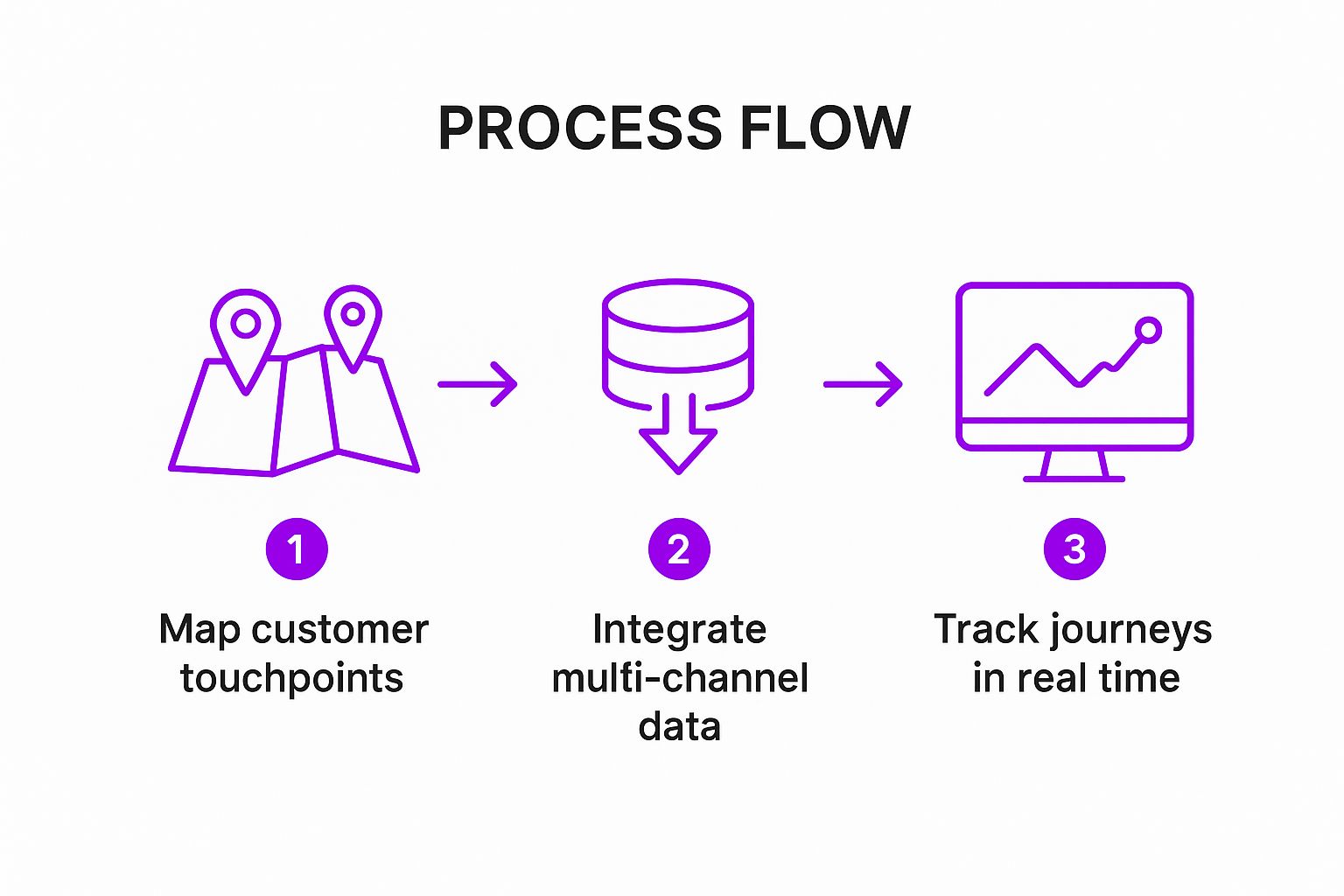
The process illustrates that successful journey mapping is a continuous loop of mapping, integrating, and tracking to adapt to changing customer behaviors.
2. Unified Customer Data Platform (CDP)
A Unified Customer Data Platform (CDP) is the engine that powers modern omnichannel experiences. It acts as a centralized command center, ingesting customer data from every conceivable touchpoint, such as your website, mobile app, CRM, physical stores, and social media. The platform then cleans, standardizes, and unifies this information to create a single, persistent, and comprehensive profile for each customer. This strategy directly dismantles data silos, which are the primary obstacle to executing effective omnichannel marketing strategies.
The ultimate goal is to achieve a true "360-degree customer view." With this unified profile, brands can deliver deeply personalized and contextually relevant messages across all channels, ensuring consistency and enhancing the customer experience. For instance, a customer support agent can see a customer's recent purchases and abandoned carts, while the marketing team can exclude them from ads for products they already own.
How to Implement This Strategy
Deploying a CDP is a strategic initiative that requires careful planning, technical integration, and a clear vision for its use. It connects disparate systems to create a cohesive data ecosystem. For a robust platform, understanding cross-site tracking and how data is collected across various digital properties is fundamental to building a complete customer view.
- Define Clear Data Governance: Establish strict policies for data collection, storage, and usage from the outset to ensure consistency and compliance.
- Start with High-Value Use Cases: Begin by focusing on specific, high-impact goals, like reducing cart abandonment or improving customer segmentation, to demonstrate value quickly.
- Ensure Privacy Compliance: Build your CDP implementation with GDPR, CCPA, and other privacy regulations in mind from day one to avoid costly future revisions.
- Invest in Data Quality: Implement processes for ongoing data cleansing and validation. A CDP is only as powerful as the quality of the data it contains.
- Train Your Teams: Equip your marketing, sales, and service teams with the necessary training to leverage the new platform's capabilities and workflows effectively.
3. Progressive Web Apps (PWA) Integration
Progressive Web App (PWA) integration is a strategy that bridges the gap between a responsive website and a native mobile application. It delivers an app-like experience directly through a web browser, providing speed, reliability, and engaging features like push notifications and offline access without requiring an app store download. This approach is a cornerstone of modern omnichannel marketing strategies because it creates a consistent, high-performance experience on any device, ensuring users can interact with your brand seamlessly whether they are online or offline.
The goal is to provide the rich functionality of a native app with the accessibility of the web. By eliminating the friction of downloading from an app store, brands can increase adoption and engagement. For example, Starbucks saw a 2x increase in daily active users after launching its PWA, while Alibaba achieved a 76% increase in conversions, showcasing the technology's powerful impact on user behavior.
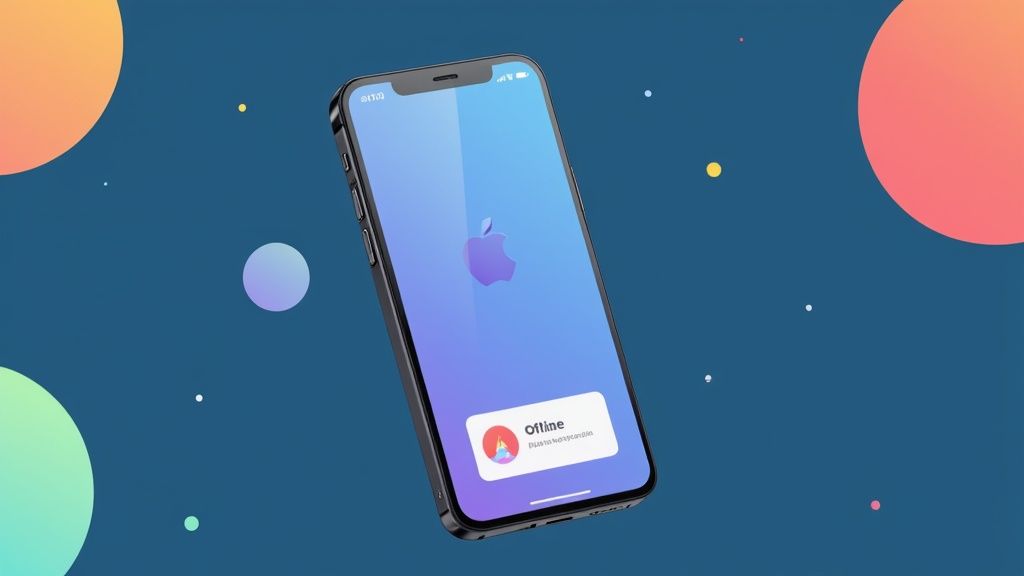
How to Implement This Strategy
Implementing a PWA requires a focus on technical performance and user experience to ensure it feels like a native application. It leverages modern web capabilities to deliver a fast, integrated, and reliable experience for every user, regardless of their network connection.
- Implement Service Workers: Use service workers to enable core PWA features like offline functionality and background syncing. This allows users to browse products and even add items to their cart without an internet connection.
- Focus on Core User Journeys: Prioritize essential features for your PWA. Identify the most critical actions users take, such as browsing popular categories or completing a purchase, and optimize them for a fast, app-like experience.
- Optimize for Mobile-First: Design with a mobile-first mindset, ensuring the layout, navigation, and interactions are intuitive on smaller screens. Use an "app shell" architecture to load the user interface instantly.
- Test Across Devices and Browsers: Thoroughly test your PWA on various browsers (Chrome, Safari, Edge) and devices to guarantee a consistent and bug-free experience for all users. This ensures your omnichannel presence is reliable.
4. Social Commerce Integration
At its core, social commerce integration is the strategy of transforming social media platforms from discovery channels into direct, seamless points of sale. It involves embedding shopping features, product catalogs, and secure checkout processes directly within social apps like Instagram, Facebook, and TikTok. This powerful approach meets customers exactly where they spend their time, drastically reducing friction by eliminating the need to leave the platform to make a purchase. As a vital component of modern omnichannel marketing strategies, it creates a fluid, in-the-moment shopping experience that captures impulse buys and drives conversions.

The goal is to make the path from product discovery to purchase as short and intuitive as possible. Instead of just seeing an ad and clicking to a website, customers can tap a product tag, add it to their cart, and check out without ever leaving their social feed. This creates a cohesive brand experience, for instance, allowing a shopper who saw a Nike sneaker drop on Instagram to buy it instantly, or a Warby Parker customer to virtually try on glasses and purchase them through Facebook.
How to Implement This Strategy
Successfully integrating social commerce requires a platform-specific approach and a deep understanding of your audience's social behavior. It's about creating authentic shopping moments, not just broadcasting product listings.
- Create Platform-Specific Content: Avoid simply cross-posting the same product images everywhere. Tailor your content to the native format of each platform, like creating engaging TikTok videos or visually stunning Instagram Reels.
- Leverage User-Generated Content (UGC): Encourage customers to share photos with your products and feature this content in your social shops. UGC acts as powerful social proof, building trust and authenticity.
- Utilize Social Listening: Monitor conversations and trends on social media to identify which of your products are generating buzz. Feature these trending items prominently in your social storefronts.
- Implement Retargeting Campaigns: For users who add items to their cart but don't complete the purchase, use targeted ads on the same social platform to remind them and encourage them to finish checking out.
- Partner with Micro-Influencers: Collaborate with influencers who have a genuine connection with their audience. Their authentic recommendations can drive significant traffic and sales to your integrated social shops.
Integrating these tactics is foundational. Implementing strong Social Media Marketing Best Practices for 2025 ensures that your social channels seamlessly contribute to a cohesive and personalized customer experience across all touchpoints.
5. Voice Commerce Optimization
Voice commerce optimization is a forward-thinking strategy that adapts your brand’s product discovery, purchasing, and customer service processes for voice-activated devices like smart speakers and virtual assistants. This approach prepares businesses for the accelerating shift towards conversational commerce, where customers interact with brands using natural language commands. By creating a voice-first experience, you can meet customers in a growing, hands-free channel, making interactions more convenient and accessible. This is a crucial component of modern omnichannel marketing strategies, as it integrates a new, highly personal touchpoint into the customer journey.
The goal is to enable seamless transactions and support without requiring a screen. For example, a customer should be able to reorder their favorite coffee pods or ask for stain removal tips from your brand simply by speaking to their device. When executed well, this strategy reduces friction in the buying process for repeat purchases and builds brand affinity by offering genuinely helpful, on-demand assistance.
How to Implement This Strategy
Implementing a voice commerce strategy requires optimizing your product data and content for conversational queries and building intuitive voice applications (or skills). It’s about translating your brand experience into an audio-first format that is both functional and engaging.
- Optimize for Conversational Keywords: Structure your product descriptions and FAQs to answer natural language questions (e.g., "What are the best running shoes for flat feet?").
- Focus on Simple Reorders: Begin by enabling voice purchasing for frequently bought, low-consideration items, as this is the most common use case. Domino's successfully did this by allowing customers to reorder their favorite pizza via Alexa.
- Develop a Voice Persona: Create a consistent brand voice and personality for your voice assistant interactions to make the experience more memorable and aligned with your brand identity.
- Build a Custom Skill or Action: Use platforms like Amazon Alexa Skills Kit or Google Actions to create custom voice applications. Tide’s skill, for instance, offers step-by-step advice on removing hundreds of different stains, providing value beyond the transaction.
- Implement Voice Analytics: Track user commands, successful interactions, and points of failure to understand customer behavior and continuously refine your voice experience.
6. Augmented Reality (AR) Shopping Experiences
Augmented reality (AR) shopping experiences use technology to bridge the gap between the digital and physical worlds, allowing customers to visualize products in their own space or on themselves before making a purchase. This innovative strategy directly addresses online shopping's biggest drawback: the inability to physically interact with an item. By superimposing digital information onto the real world via a smartphone camera, AR reduces purchase anxiety, boosts conversion rates, and significantly lowers return rates for products where fit and appearance are critical. This makes it one of the most immersive and effective omnichannel marketing strategies for modern retail.
The goal of AR is to create "try-before-you-buy" scenarios that build confidence and engagement. For example, IKEA's Place app lets users see how a sofa would look in their living room, while Sephora's Virtual Artist allows for a virtual makeup try-on. These experiences move beyond simple product images to offer a personalized and interactive preview, making the online shopping journey as tangible as an in-store visit.

How to Implement This Strategy
Deploying an AR experience requires a focus on solving genuine customer problems rather than simply using technology for its own sake. The most successful AR integrations are practical, user-friendly, and seamlessly integrated into the existing shopping path.
- Target High-Return Categories: Begin by implementing AR for products with high return rates due to size, fit, or style uncertainty, such as furniture, apparel, eyewear, or cosmetics.
- Ensure Cross-Platform Accessibility: Develop AR features that work flawlessly on both iOS and Android devices to avoid alienating a significant portion of your customer base. Platforms like 8th Wall offer web-based AR that doesn't require an app download.
- Create Shareable Moments: Design the AR experience to be fun and easily shareable on social media. This encourages organic user-generated content and amplifies your brand's reach.
- Focus on Utility: Ensure the AR tool solves a real customer pain point. For instance, Nike Fit uses AR to scan feet and recommend the perfect shoe size, directly addressing a common online purchasing challenge. For a deeper dive into how artificial intelligence is transforming and accelerating immersive customer experiences, explore the impact of AI-Driven Augmented Reality.
7. Predictive Inventory and Dynamic Fulfillment
Predictive inventory and dynamic fulfillment represent a sophisticated, data-driven approach to supply chain management within an omnichannel framework. This strategy leverages machine learning and predictive analytics to forecast demand, optimize inventory placement across various locations like warehouses and retail stores, and intelligently select the best fulfillment method for each order. By anticipating what customers will buy and where, businesses can ensure product availability, reduce shipping times, and minimize costs. This is one of the more advanced omnichannel marketing strategies, as it directly connects marketing-driven demand to back-end operational efficiency.
The core goal is to move from a reactive to a proactive inventory model. Instead of just replenishing stock when it runs low, companies like Amazon and Walmart use predictive models to place products closer to anticipated demand hotspots before orders are even placed. This allows them to offer faster, more reliable delivery promises, which is a powerful competitive advantage and a crucial part of a seamless customer experience.
How to Implement This Strategy
Implementing this strategy requires a strong foundation in data analytics and integration between your eCommerce platform, inventory management system, and warehouse management system (WMS). It’s about making your supply chain as intelligent as your marketing.
- Start with High-Velocity Products: Begin by applying predictive models to your best-selling or high-velocity items. This focused approach allows you to refine your algorithms and demonstrate ROI before a full-scale rollout.
- Integrate Diverse Data Sets: Enhance prediction accuracy by incorporating external data sources such as weather forecasts, local events, and seasonal trends alongside your historical sales data.
- A/B Test Fulfillment Methods: Experiment with different fulfillment options like ship-from-store, buy-online-pickup-in-store (BOPIS), or using micro-fulfillment centers. Use A/B testing to determine which methods are most cost-effective and provide the best customer experience for different regions or product types.
- Implement Smart Buffers: Use predictive analytics to set dynamic safety stock levels for critical items, ensuring you can absorb unexpected demand spikes without stockouts. This is far more efficient than maintaining static, high-cost safety stock across all products.
- Leverage AI Platforms: Consider specialized solutions from providers like Blue Yonder or Oracle Retail. These platforms offer pre-built AI and machine learning models designed to manage complex, omnichannel inventory challenges and can significantly accelerate implementation.
8. Clienteling and Digital Personal Shopping
Clienteling merges the high-touch, personalized service of traditional personal shopping with modern digital tools to create a premium, relationship-driven customer experience. This strategy empowers sales associates with detailed customer data, purchase history, and preferences right at their fingertips, allowing them to provide tailored recommendations whether the customer is in-store, on the app, or browsing online. It transforms a transactional relationship into a consultative one, making it a cornerstone of advanced omnichannel marketing strategies focused on loyalty and high-value customers.
The core objective is to bridge the gap between digital and physical retail, ensuring the personalized attention a customer receives in-store can be replicated and continued across digital channels. For instance, an associate can follow up on an in-store conversation with a curated lookbook sent via email or a messaging app, creating a continuous, personal dialogue that drives both engagement and sales. This approach, used effectively by brands like Nordstrom and Burberry, demonstrates a deep understanding of individual customer needs.
How to Implement This Strategy
Successfully integrating clienteling requires a blend of sophisticated technology and dedicated staff training. It’s about arming your team with the right tools and insights to build genuine customer relationships.
- Integrate Clienteling Tools with CRM: Connect your clienteling platform (like Tulip or Salesforce Commerce Cloud) with your master CRM and customer data platform. This ensures associates have a complete, 360-degree view of every customer's history and interactions.
- Train Staff on Data Interpretation: Beyond just using the software, train retail associates to interpret customer data to make insightful, personalized recommendations. This human element is what makes clienteling truly effective.
- Create Seamless Digital-to-Human Handoffs: Design clear pathways for customers to connect with a personal stylist or associate from your website or app. This could be a "chat with a stylist" button or a feature to book a virtual consultation.
- Measure Relationship-Based Metrics: Track success not just by immediate sales but also by metrics like customer lifetime value (CLV), repeat purchase rate, and customer satisfaction scores for clients engaged in personal shopping.
9. Subscription and Membership Integration
Subscription and membership integration transforms one-time buyers into long-term, loyal customers by weaving recurring value into the entire brand experience. This approach goes beyond a simple transaction, creating an ongoing relationship that delivers predictable revenue and deepens customer engagement across all channels. By integrating a membership program into your mobile app, in-store experience, and online portal, you create a powerful ecosystem that encourages repeat business and boosts lifetime value. This is one of the most effective omnichannel marketing strategies for building a dedicated community around your brand.
The goal is to make membership benefits feel seamless and ever-present, whether a customer is browsing online, ordering via an app, or visiting a physical location. For instance, a member should be able to redeem exclusive rewards in-store just as easily as they access members-only content online. This consistency reinforces the value of the program and makes the customer feel like a valued insider, regardless of how they choose to interact with your brand.
How to Implement This Strategy
A successful membership program requires a thoughtful approach to value delivery, personalization, and technology. It must be more than just a discount club; it needs to offer tangible, exclusive benefits that are accessible everywhere.
- Deliver Consistent Value: Go beyond discounts. Offer members exclusive access to products like Nike's SNKRS app, free shipping and content like Amazon Prime, or community-focused perks.
- Personalize the Offering: Use customer data to tailor subscription boxes, recommend relevant members-only content, or offer personalized rewards that resonate with individual preferences.
- Implement Flexible Options: Allow members to easily pause, upgrade, or modify their subscriptions. This flexibility reduces friction and decreases churn by accommodating changing customer needs.
- Monitor Key Engagement Metrics: Track metrics like repeat purchase rate, reward redemption rates, and churn risk to proactively identify disengaged members and re-engage them with targeted offers. For a deeper dive into structuring these programs, you can explore various eCommerce subscription models.
10. Real-Time Personalization Engine
A real-time personalization engine is an advanced system that dynamically tailors content, product recommendations, and offers to individual users based on their immediate behavior and historical data. This engine processes live data signals, such as clicks, browsing patterns, and cart additions, across all channels to deliver a hyper-relevant experience at that exact moment. This is one of the most sophisticated omnichannel marketing strategies, moving beyond static segmentation to treat each user as an individual with evolving needs.
The ultimate goal is to make every interaction feel uniquely crafted for the customer, whether they are on your website, using your mobile app, or opening an email. By adapting instantly to user actions, a personalization engine can significantly boost engagement, conversion rates, and loyalty. For instance, Amazon’s engine adjusts recommended products on its homepage based on what a user just viewed, creating a fluid and responsive shopping journey.
How to Implement This Strategy
Deploying a real-time personalization engine requires a blend of data integration, smart technology, and a clear strategic vision. It involves connecting your customer data sources to an intelligent system that can make instant decisions.
- Start with Rules-Based Logic: Before investing in complex AI, begin with simple "if-then" personalization rules. For example, show a specific banner to users who have visited a certain product category three times.
- Centralize Customer Data: A Customer Data Platform (CDP) is essential for unifying user data from all touchpoints, providing the single customer view needed for real-time decision-making.
- Ensure High Performance: Personalization scripts can slow down your site. Work with your development team to implement technology like Dynamic Yield or Optimizely asynchronously to avoid impacting load times.
- Test and Measure Impact: Continuously A/B test your personalization efforts against a control group to measure their direct impact on key metrics like conversion rates, average order value, and customer lifetime value.
- Provide User Control: Offer transparency and allow customers to manage their personalization settings. This builds trust and addresses privacy concerns, which is critical for long-term relationships.
Omnichannel Strategies Feature Comparison
Orchestrating Your Omnichannel Future
Implementing effective omnichannel marketing strategies is no longer just a competitive advantage; it is the fundamental framework for modern commerce. The journey through the ten strategies detailed in this article, from foundational data unification to futuristic AR experiences, illuminates a clear path forward. The core principle is not to simply exist on multiple channels, but to weave them into a single, intelligent, and cohesive customer-centric tapestry.
This shift from multichannel chaos to omnichannel harmony requires a profound change in perspective. Instead of viewing your website, mobile app, social media storefront, and physical locations as separate entities, you must see them as interconnected touchpoints in a continuous conversation with your customer. The goal is to make the transition between these points so seamless, so intuitive, that the customer doesn't even notice the technology powering it. They only feel understood, valued, and effortlessly guided toward what they need.
Key Takeaways for Your Omnichannel Blueprint
As you move from theory to implementation, remember these critical takeaways that underpin all successful omnichannel marketing strategies:
- Data is the Foundation: A Unified Customer Data Platform (CDP) isn't just another tool; it's the central nervous system of your entire operation. Without clean, accessible, and real-time data, personalization remains a guessing game, and seamless experiences are impossible.
- The Journey is Paramount: Before investing in flashy tech like AR or voice commerce, you must deeply understand your customer's path. Cross-Channel Customer Journey Mapping is a non-negotiable first step that will inform every subsequent decision and resource allocation.
- Technology Serves Experience, Not the Other Way Around: Whether it’s a Progressive Web App (PWA) for speed, a real-time personalization engine for relevance, or predictive inventory for reliability, the technology you choose must solve a specific customer friction point. The 'wow' factor should come from the flawless experience, not just the novelty of the feature.
- Consistency Builds Trust: Every interaction, regardless of the channel, must reflect your brand's voice, values, and promise. From the personalized recommendations of a clienteling app to the transactional ease of social commerce, this consistency is what transforms one-time buyers into loyal brand advocates.
Your Actionable Next Steps
Embarking on this transformation can feel daunting, but it’s a journey of a thousand steps that begins with one. Start by focusing on the low-hanging fruit that offers the highest impact for your specific business. Don't try to implement all ten strategies at once.
- Conduct a Channel Audit: Where are your customers actually interacting with you? Where are the biggest drop-off points and moments of frustration? Use this data to prioritize.
- Focus on Foundational Data: Assess your current data infrastructure. Can you confidently say you have a single, unified view of your customer? If not, exploring a CDP should be your top priority.
- Pilot a Single Strategy: Choose one high-impact area, such as improving your mobile experience with PWA features or integrating a more robust social commerce checkout, and execute it flawlessly. Measure the results, learn from the process, and then expand.
Ultimately, mastering these omnichannel marketing strategies is about future-proofing your brand. It’s about building a resilient, agile, and deeply customer-aware business that can adapt to changing behaviors and new technologies. By committing to this holistic vision, you are not just optimizing marketing channels; you are architecting a sustainable engine for growth, loyalty, and lasting market relevance.
Feeling ready to build a truly cohesive and high-converting customer experience but need an expert partner to navigate the technical complexities? The team at ECORN specializes in designing and developing sophisticated eCommerce solutions, turning ambitious omnichannel marketing strategies into tangible, revenue-driving realities on platforms like Shopify Plus. Explore how ECORN can help you orchestrate your brand's future.








